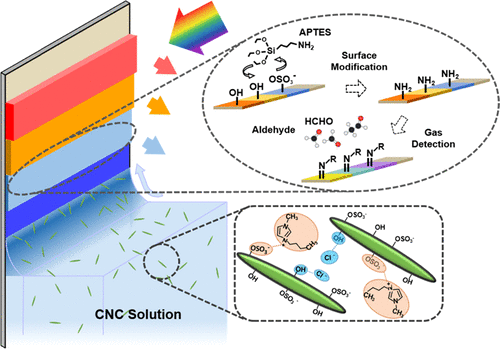当前位置:
X-MOL 学术
›
ACS Appl. Mater. Interfaces
›
论文详情
Our official English website, www.x-mol.net, welcomes your
feedback! (Note: you will need to create a separate account there.)
Cellulose Nanocrystal-Based Colored Thin Films for Colorimetric Detection of Aldehyde Gases
ACS Applied Materials & Interfaces ( IF 8.3 ) Pub Date : 2018-03-02 00:00:00 , DOI: 10.1021/acsami.7b19738 Wonbin Song 1 , Jong-Kwon Lee 2 , Mi Sic Gong 3 , Kwang Heo 4 , Woo-Jae Chung 3 , Byung Yang Lee 1
ACS Applied Materials & Interfaces ( IF 8.3 ) Pub Date : 2018-03-02 00:00:00 , DOI: 10.1021/acsami.7b19738 Wonbin Song 1 , Jong-Kwon Lee 2 , Mi Sic Gong 3 , Kwang Heo 4 , Woo-Jae Chung 3 , Byung Yang Lee 1
Affiliation

|
We demonstrate a controllable and reliable process for manifesting color patterns on solid substrates using cellulose nanocrystals (CNCs) without the use of any other chemical pigments. The color can be controlled by adjusting the assembly conditions of the CNC solution during a dip-and-pull process while aiding the close packing of CNCs on a solid surface with the help of ionic-liquid (1-butyl-3-methylimidazolium) molecules that screen the repelling electrostatic charges between CNCs. By controlling the pulling speed from 3 to 9 μm/min during the dip-and-pull process, we were able to control the film thickness from 100 to 300 nm, resulting in films with different colors in the visible range. The optical properties were in good agreement with the finite-difference time-domain simulation results. By functionalizing these films with amine groups, we developed colorimetric sensors that can change in color when exposed to aldehyde gases such as formaldehyde or propanal. A principal component analysis showed that we can differentiate between different aldehyde gases and other interfering molecules. We expect that our approach will enable inexpensive and rapid volatile organic compound detection with on-site monitoring capabilities.
中文翻译:

基于纤维素纳米晶体的彩色薄膜,用于比色法检测醛类气体
我们展示了使用纤维素纳米晶体(CNC)在固态基材上显示颜色图案的可控且可靠的过程,而无需使用任何其他化学颜料。可以通过在浸入和拉制过程中调整CNC溶液的组装条件来控制颜色,同时借助离子液体(1-丁基-3-甲基咪唑鎓)分子来帮助将CNC紧密堆积在固体表面上屏蔽CNC之间的排斥静电。通过在浸入和拉出过程中将牵引速度控制在3至9μm/ min,我们能够将膜厚度控制在100至300 nm,从而在可见范围内产生具有不同颜色的膜。光学性能与时域有限差分仿真结果吻合良好。通过用胺基官能化这些薄膜,我们开发了比色传感器,当暴露于甲醛或丙醛等醛类气体时,其颜色会发生变化。主成分分析表明,我们可以区分不同的醛气体和其他干扰分子。我们希望我们的方法能够通过现场监视功能实现廉价且快速的挥发性有机化合物检测。
更新日期:2018-03-02
中文翻译:

基于纤维素纳米晶体的彩色薄膜,用于比色法检测醛类气体
我们展示了使用纤维素纳米晶体(CNC)在固态基材上显示颜色图案的可控且可靠的过程,而无需使用任何其他化学颜料。可以通过在浸入和拉制过程中调整CNC溶液的组装条件来控制颜色,同时借助离子液体(1-丁基-3-甲基咪唑鎓)分子来帮助将CNC紧密堆积在固体表面上屏蔽CNC之间的排斥静电。通过在浸入和拉出过程中将牵引速度控制在3至9μm/ min,我们能够将膜厚度控制在100至300 nm,从而在可见范围内产生具有不同颜色的膜。光学性能与时域有限差分仿真结果吻合良好。通过用胺基官能化这些薄膜,我们开发了比色传感器,当暴露于甲醛或丙醛等醛类气体时,其颜色会发生变化。主成分分析表明,我们可以区分不同的醛气体和其他干扰分子。我们希望我们的方法能够通过现场监视功能实现廉价且快速的挥发性有机化合物检测。











































 京公网安备 11010802027423号
京公网安备 11010802027423号